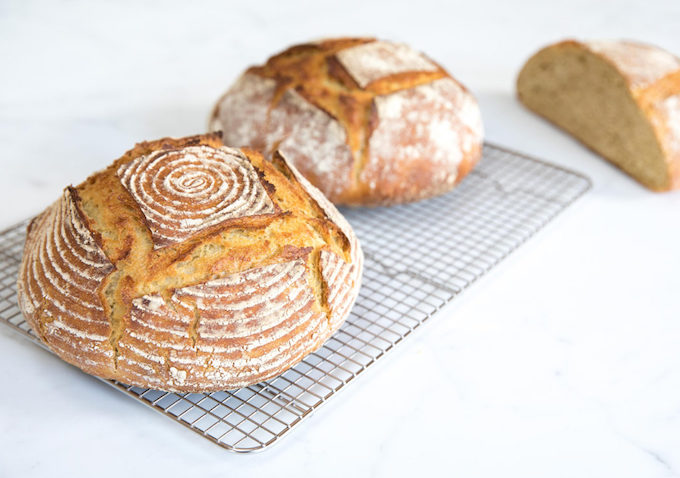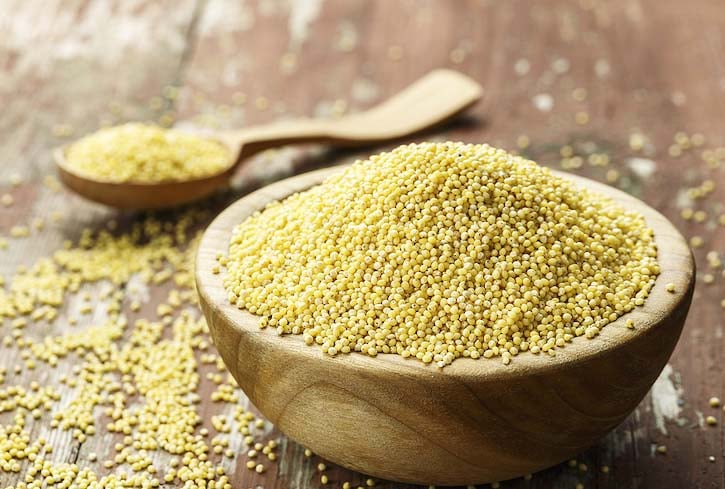The description of grains as “the staff of life” is particularly apt applied to ancient grains—civilizations past relied on them as major sources of protein and other nutrients. The superbly nourishing profiles of these “new” ancient grains are the most compelling reason they’ve been revived for today’s consumers.

Most grains are ancient, no matter their origin. Familiar ones include rice, barley, millet, and certain forms of wheat, for example. They’ve all been cultivated and used as sustenance for millennia.
Here we turn the spotlight on ancient grains that have made headway into the North American market starting around the 1970s forward.
The following list features the grains you’ll find here, in alphabetic order. Link through to the guides at the end of each entry to find tips on using and lots of recipes.
Amaranth
Einkorn
Farro
Fonio
Forbidden rice
Freekeh
Kamut ®
Kañiwa
Millet
Quinoa
Spelt
Teff

Amaranth
Once a revered crop of the ancient Aztecs, amaranth has become somewhat of a familiar natural food item in North America and beyond. The nutritional profile of amaranth is so impressive that when it burst on the scene a few decades ago, it was cited as one of the world’s most promising foods by the National Academy of Sciences.
The flavor of cooked amaranth is strong, often described as nutty and sweet, but it’s more complex than that. Even its aroma is distinct and may not be to everyone’s liking. For lots more on this tiny yet mighty grain’s characteristics and uses, see our Guide to Amaranth Grain and Flour.

Einkorn
Widely considered to be the oldest grain in the history of agriculture, today, einkorn is most commonly used as a flour. One of the most recent of ancient grains to be revived for modern market, einkorn is actually one of the oldest forms of cultivated wheat.
Higher concentration of both nutrients and flavors makes it a beneficial and delectable flour to use in whatever recipes you’d normally use unbleached white or whole wheat pastry flour.
It’s a low-gluten flour, so not ideal for yeasted breads, but it’s fantastic for all kinds of other baked goods, in which it yields a delectably tender crumb. See this site’s Guide to Baking with Einkorn Flour; and for lots more on einkorn’s history and lots more, explore Jovial Foods and Einkorn.com.

Farro
Farro is an ancient wheat grain that has made a big comeback in contemporary cooking. Renowned for its uniquely nutty, earthy flavor, and satisfying chewy texture, it’s no surprise that chefs and home cooks alike are falling in love with this timeless superfood, which is especially good in pilafs, salad, and soups.
Contrary to common belief, “farro” isn’t just one grain, but three. Einkorn (farro piccolo), emmer (farro medio), and spelt (farro grande) are typically referenced as their own distinct entities but are actually just varieties of farro. Emmer is what you’ll find in most US stores sold simply as “farro.”
This guide to farro offers lots of tips on how to buy and cook it, varieties, and easy ideas for using. See our Guide to Farro — with Tips, Ideas, & Recipes.

Fonio
The latest ancient grain to take the food scene by storm, fonio is grown primarily in North Africa, where it has been a staple food for millennia. It thrives in the harsh, arid conditions where few other crops could survive.
You may not have spotted it in grocery or natural food stores yet, as it’s been slow to catch on in North America, but fonio is slowly making inroads and is readily available online.
Fonio is similar to couscous in appearance and preparation. It cooks very quickly with little effort, so it’s an excellent side dish to boost many types of meals. This Guide to Fonio will give you its historic overview, plus lot of tips on how to buy and cook it, easy ways to use it, and links to recipes.

Forbidden Rice
Black rice, often referred to as “forbidden rice” or “emperor’s rice,” got its name because it was originally reserved for the Chinese emperor. Black rice has a slightly sweet, nutty flavor and has been eaten throughout China for thousands of years.
The grain’s dark purple hues come from high levels of the antioxidant, anthocyanin which is also responsible for the deep coloration of eggplant, blueberries, and grapes.
Black rice is significantly harder to grow than any other rice variety because it only yields about ten percent of the harvest that other rice varieties do. Due to the grain’s low yield, it is more expensive — which is why it was originally reserved for the Chinese emperor at the time it was first discovered. Learn lots more in this site’s Guide to Black Forbidden Rice, with Tips & Recipes.

Freekeh
Unlike other newly rediscovered ancient grains, freekeh isn’t a wholly separate, unique strain. It’s hard durum wheat that’s been harvested early, while the grains are still tender and green. The kernels are then roasted or smoked, dried, and polished. As a form of cracked durum wheat with a smoky flavor, it’s a great pilaf or salad grain.
Often mentioned in the same breath as other grain heroes like quinoa, spelt, amaranth, and farro, there are still many misconceptions about this versatile ingredient.
Whether you call it freekeh, frikeh, farik, or fireek, it’s always versatile and tastes great. All you need to know about how to buy, cook, and use it will be found in this Guide to Freekeh.

Kamut®
A relative of durum wheat, kamut was a staple in the Nile region thousands of years ago. Its full name is khorsoran wheat, was virtually lost until the 1970s, when an enterprising Montana wheat farmer brought it back from extinction and named it Kamut®, an ancient Egyptian word for grain. Thus, it’s a brand name, always capitalized.
Like spelt, Kamut is touted as less allergenic and more digestible than common hard wheats. It’s most widely used as a flour, and though unrefined, is fine and powdery, resulting in light-textured baked goods.
Kamut is pleasantly nutty and aromatic as a rolled grain, pasta flour, and in baked goods. Find out more about Kamut grain and Kamut flour.
 Photo: Hannah Kaminsky (originally published on Vegkitchen.com)
Photo: Hannah Kaminsky (originally published on Vegkitchen.com)
Kañiwa
Hailing from the same region as Quinoa, its better-known relative, kañiwa grown in Peru and Bolivia, kañiwa is the smaller, darker, and sweeter grain-like seed striving to make headway in the North American natural foods market. Though it has been part of the staple diet of populations in the South American Andes for generations, it has only recently been discovered by Western civilizations.
Kañiwa, sometimes called “baby quinoa,” comes from a flowering plant called goosefoot, and looks like an even tinier form of red quinoa. If you think quinoa is a superfood, kañiwa’s nutritional profile is even more amazing — higher in protein and many nutrients — and that’s saying a lot.
The two ancient grains, kañiwa and quinoa, are often compared. Take a quick look at how they’re alike and different. And there’s lots more in this site’s Guide to Kañiwa.

Millet
If this tiny, round yellow seed looks familiar to you, it may be because it’s also a common component of birdseeds mixes. But this versatile grain isn’t just for the birds. Bland in flavor and often mushy in texture, millet may not inspire culinary excitement, but it’s versatile, nourishing, and gluten-free.
Millet holds a venerable place in the history of cultivated grains. It was widely used in China before it was overtaken by rice, and its recorded use stretches back to ancient Egypt. It’s still a staple grain across the African continent, and in some cuisines of India. Millet’s greatest claim to fame is arguably its favored use among the Hunza people of the Himalayan foothills, known for their longevity.
Millet has a wide range of uses, from breakfast porridge to pilafs and salads. It’s an ideal grain for stuffing into salads or using in homemade veggie burgers. Find out lots more in this site’s Guide to Millet.

Quinoa
Not long ago considered a specialty food, quinoa has officially entered the mainstream. High in protein, quick to cook, and with a distinct flavor, quinoa has earned its place as a staple culinary grain (that’s botanically a seed). Pronounced KEEN-wa, it’s the Quechua Indian word for mother—reflecting the reverence bestowed on it as “the mother grain.”
Traditionally grown in the Andes, quinoa has a tiny disk shape, about the size of sesame seeds, and comes in tan, red, or black. Sometimes they’re marketed mixed, which make for attractive salads and pilafs.
With its mild, distinctly nutty flavor and light, fluffy texture, and quick cooking time (about 15 minutes), quinoa is a boon to busy cooks, and it’s gluten-free, too. Find lots of tips and ways to use it in our Guide to Quinoa: How to Cook and Use the Versatile Supergrain.

Spelt
Among the most ancient of cultivated wheats, the recorded use of spelt has been most prevalent in Europe, where it goes back thousands of years. High in fiber and more easily digested than other hard wheats, its flavor and aroma is as familiar as whole wheat, yet richer and more complex.
As mentioned, spelt is a form of the farro (listing above). This separate listing is mainly to highlight spelt’s us as a flour — you won’t find anything labeled “farro flour,” at least not in North America.
Spelt flour is a fantastic choice for use in all kinds of baked goods — cookies, cakes, muffins, quick breads, and more, in which it produces a tender crumb, much like pastry flour. It makes great pastas, pizza crust, and both sweet and savory pancakes. Learn lots more in this site’s Guide to Spelt Grain and Spelt Flour.

Teff
What looks like a poppy seed, cooks like a whole grain, has more protein than quinoa, and is technically classified as a cultivated annual grass? That’s not a trick question; the answer is teff, one of the world’s oldest domesticated plants.
An indispensable staple crop of Ethiopia, today, much of the teff in the Western market is grown in Idaho and marketed as Maskal Teff. Although you’re less likely to come across whole teff grain (which is technically a seed) than the flour, it is making its way to greater renown thanks to surging interest in superfoods.
Teff’s best-known use is as the flour that goes into making injera, the moist, soft flatbread you may have encountered in Ethiopian restaurants. This site’s Guide to Teff Grain and Teff Flour will give you all the information you need to buy, cook, and enjoy this supergrain.
Explore more of this site’s Good Food Guides.
Photos: Bigstock

Leave a Reply